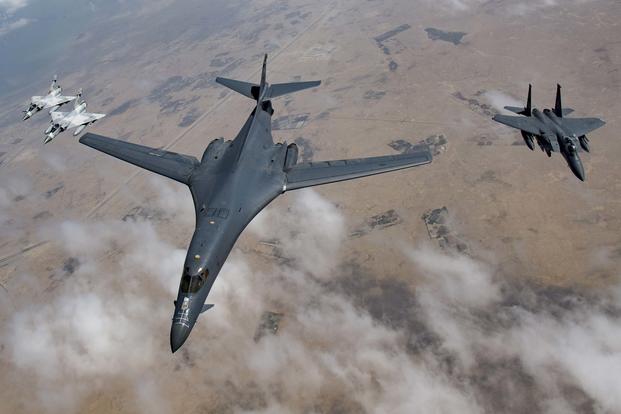Despite high demand, there are only a handful of B-1B Lancer bombers available to take off at a moment's notice.
The head of U.S. Strategic Command (STRATCOM), Air Force Gen. John Hyten, told Senate Armed Services Committee members this week that the service has only six bombers that are ready to deploy.
"We have B-1B bombers; this is the workhorse of the Air Force today," Hyten said during his tense confirmation hearing to become vice chairman of the Joint Chiefs of Staff.
"Right now, of all of our B-1 bombers, we have six of them that are fully mission capable: five split between Ellsworth Air Force Base [South Dakota] and Dyess Air Force Base [Texas], one is a test aircraft, 15 B-1s are in depot," he said. "The remaining 39 of 44 B-1s at Ellsworth and at Dyess are down for a variety of discrepancies and inspections."
Air Force Global Strike Command (AFGSC) officials told Task & Purpose on Wednesday there are seven fully mission capable bombers.
Related content:
- B-1B Bomber Fleet Resumes Flight Operations After Latest Grounding
- Air Force Planning Shorter, More Frequent Strategic Bomber Rotations
- Anatomy of a B-1 Bomber Training Mission
Hyten said the B-1 has borne the brunt of constant deployment cycles.
"We saw issues in the B-1 because we're just beating the heck out of them, deploying them, deploying them. And so we had to pull back a little bit and get after fixing those issues. And the depots can do that if they have stable funding," he said.
Gen. Tim Ray, commander of AFGSC, agreed that demand has outstripped available aircraft.
During a speech at the Deterrence Symposium in Nebraska on Wednesday, Ray spoke about "setting the pace" for deterrence, saying that sometimes the demand for resources wins out.
Earlier this year, Ray said the Air Force overcommitted its only supersonic heavy payload bomber to operations in the Middle East over the last decade, causing it to deteriorate more quickly than expected.
"We overextended the B-1s in [U.S. Central Command]," he told reporters during a breakfast with reporters April 17 in Washington, D.C. Ray said that's why he recalled the aircraft to the U.S. to receive upgrades and maintenance to prepare for the next high-end fight.
"Normally, you would commit -- [with] any bomber or any modern combat aircraft -- about 40 percent of the airplanes in your possession as a force, [not including those] in depot," he explained. "We were probably approaching the 65 to 70 percent commit rate [for] well over a decade. So the wear and tear on the crews, the maintainers, and certainly the airplane, that was my cause for asking for us to get out of the CENTCOM fight."
Last year, B-1s returned to the Middle East for the first time in nearly two-and-a-half years to take over strike missions from the B-52 Stratofortress. The last rotation of bombers from Dyess returned home March 11, according to Air Force Magazine.
By the end of March, Ray had ordered a stand-down, marking the second fleetwide pause in about a year.
AFGSC officials said that, during a routine inspection of at least one aircraft, airmen found a rigged "drogue chute" incorrectly installed in the ejection seat egress system, a problem that might affect the rest of the fleet. Ray said his immediate concern was for the aircrews' safety.
The aircraft resumed flights April 23.
The command again grounded the fleet over safety concerns last year over a problem also related to the Lancer's ejection seats. Officials ordered a stand-down June 7, 2018, which lasted three weeks while the fleet was inspected.
That pause was the direct result of an emergency landing made by a Dyess-based B-1 on May 1, 2018, at Midland Airport in Texas.
Then-Air Force Secretary Heather Wilson confirmed speculation that the B-1 had to make an emergency landing after an ejection seat didn't blow during an earlier in-flight problem.
Lawmakers took note this summer: The House Armed Services seapower and projection forces subcommittee in its markup of the fiscal 2020 National Defense Authorization Act requested that the Air Force offer a plan for how it will address the B-1's problems. Committee members were aware that the B-1's availability rates were in the single digits, according to Air Force Times.
The B-1's mission-capable rate -- the ability to fly at any given time to conduct operations -- is 51.75%, according to fiscal 2018 estimates, Air Force Times recently reported. By comparison, its bomber cousins, the B-2 Spirit and B-52 Stratofortress, have mission-capable rates of 60.7% and 69.3%, respectively.
The Air Force has 62 Lancers in its fleet. It plans to retire the bombers in 2036.
-- Oriana Pawlyk can be reached at oriana.pawlyk@military.com. Follow her on Twitter at @Oriana0214.












